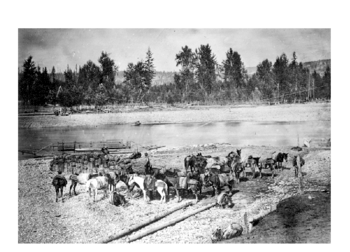Quesnel River facts for kids
Quick facts for kids Quesnel River |
|
|---|---|

Mule train at the Quesnel River 1868
|
|
| Country | Canada |
| Province | British Columbia |
| Physical characteristics | |
| Main source | Quesnel Lake Likely, British Columbia 724 m (2,375 ft) 52°36′55″N 121°34′23″W / 52.61528°N 121.57306°W |
| River mouth | Fraser River Quesnel 468 m (1,535 ft) 52°58′14″N 122°29′52″W / 52.97056°N 122.49778°W |
| Length | 100 km (62 mi) |
| Basin features | |
| Basin size | 11,500 km2 (4,400 sq mi) |
| Tributaries | |
The Quesnel River is an important river in central British Columbia, Canada. It is a major branch of the Fraser River. The Quesnel River starts at Quesnel Lake near the town of Likely.
It flows for about 100 kilometers (62 miles) to the northwest. The river then joins the Fraser River at the city of Quesnel.
Contents
River History and Names
The Quesnel River played a big part in the history of British Columbia. It was important during the Cariboo Gold Rush.
Gold Rush and Quesnel Forks
Near where the Quesnel River starts, there is a historic ghost town called Quesnel Forks. This town was a meeting point for the Quesnel and Cariboo Rivers. It was also a key spot for trails and roads leading to the goldfields.
Many gold seekers used these routes. The main roads, like the Cariboo Road, followed the Quesnel River valley. They led to gold towns such as Barkerville and Wells.
How the River Got Its Name
The river is named after Jules-Maurice Quesnel. He was an explorer who traveled this area in 1808. He explored with Simon Fraser, another famous explorer.
River Wildlife and Nature
The Quesnel River is home to many different kinds of fish. It is a very important place for nature.
Fish Species in the River
Some of the most common fish found in the Quesnel River include:
- Sockeye salmon (Oncorhynchus nerka)
- Rainbow trout (Oncorhynchus mykiss)
- Largescale sucker (Catostomus macrocheilus)
- Longnose sucker (Catostomus catostomus)
- Redside shiner (Richardsonius balteatus)
- Northern pikeminnow (Ptychocheilus oregonensis)
- Peamouth chub (Mylocheilus caurinus)
- Lake chub (Couesius plumbeus)
Salmon Run and River Health
The river is especially famous for its sockeye salmon. These salmon swim up the river to lay their eggs. This journey is called a "salmon run." In the late 1900s, the number of sockeye salmon in the Quesnel River grew a lot. Sometimes, it even had more salmon than the Adams River, which is another big salmon river.
However, in August 2014, there was an incident where a large amount of mining waste entered the river system. This event affected the river, its wildlife, and nearby water sources. Efforts are ongoing to help the river recover.
See also
In Spanish: Río Quesnel para niños

